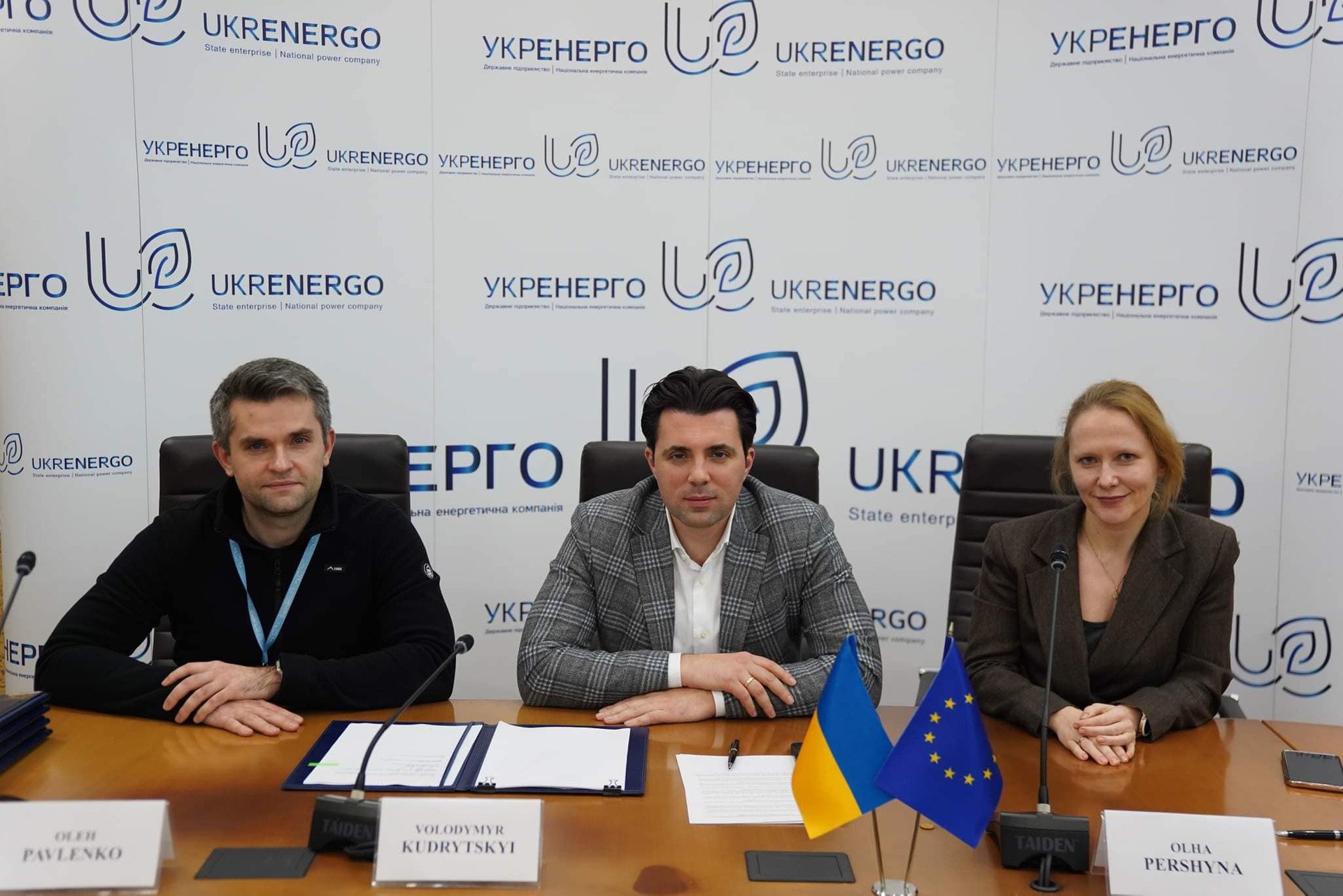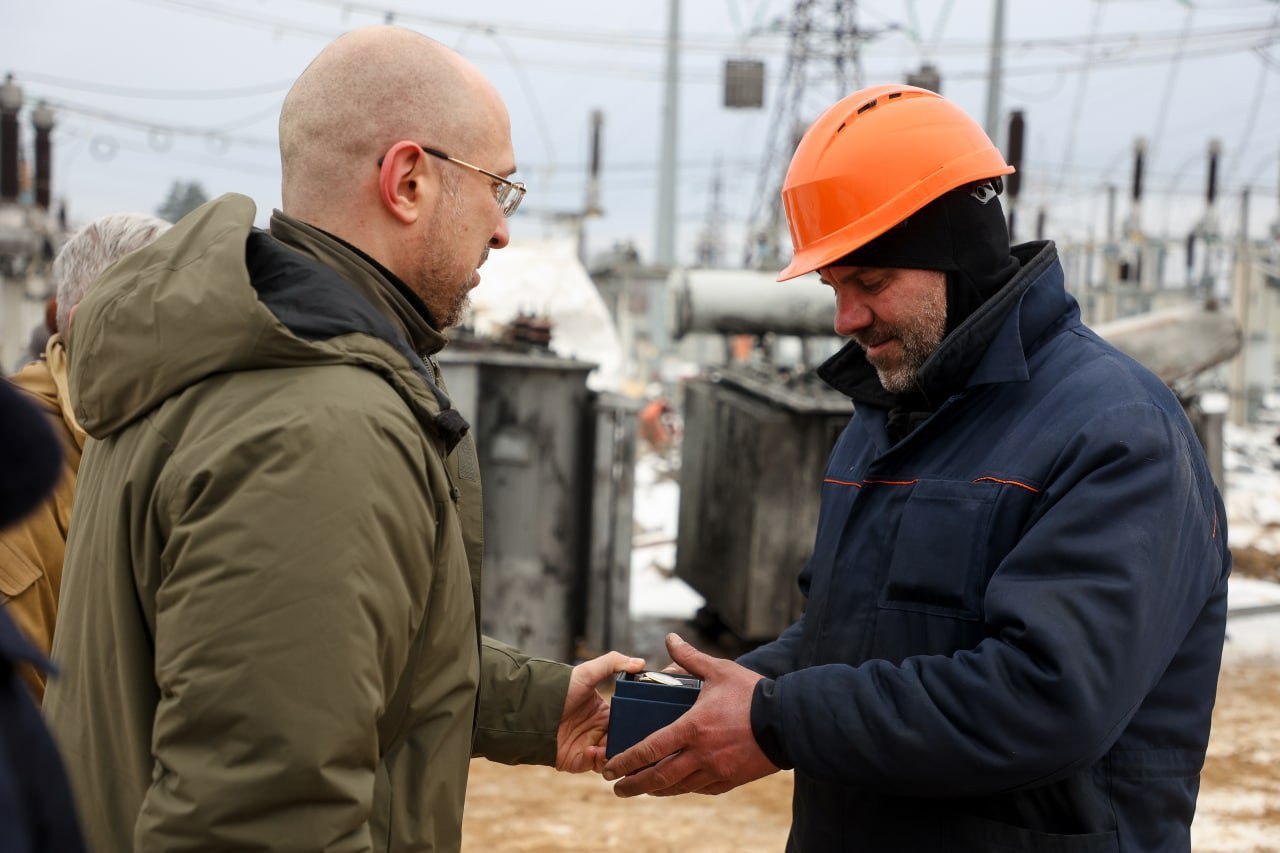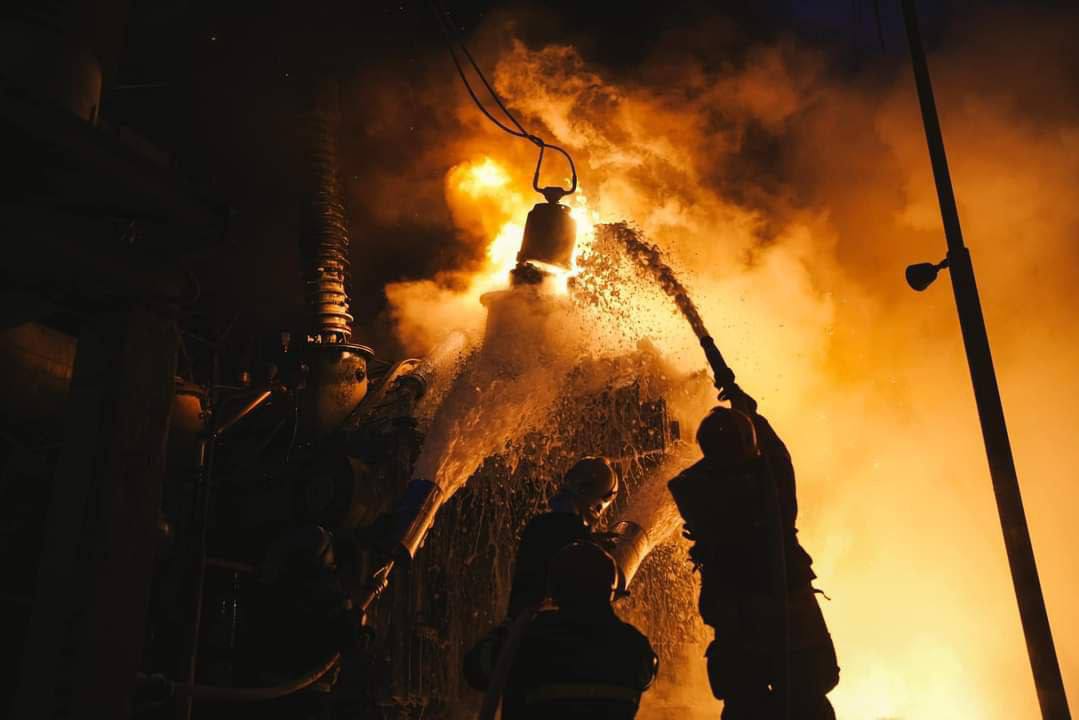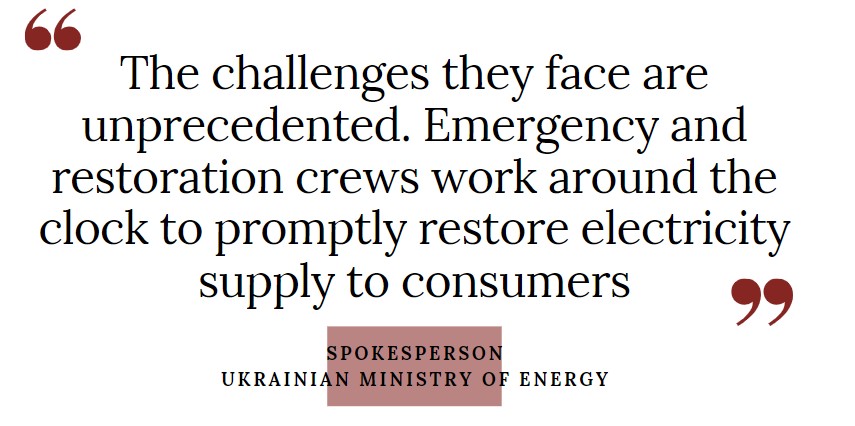As its invasion of Ukraine drags into its tenth month, Russia has largely failed to achieve any of its objectives put forward at the start of its so-called “special military operation.” In his frustration, Russia's President Vladimir Putin and his generals have brought their war to the ordinary citizens of Ukraine, striking at civilian infrastructure, and notably, the energy grid.
At the time of publication, around half of Ukraine’s energy infrastructure has been destroyed by Russian attacks. These attacks have led to the deaths of at least 77 civilians and 272 injuries.
Despite massive bombardments, both against energy generation sites and substations, civilians in the capital carry on with their lives however they can. Many homes still have power — albeit intermittently — and Ukrainian authorities continue to ensure power to critical infrastructure such as hospitals, administration buildings, and commercial infrastructure.
However, as Russia steps up its attacks, thousands of people, especially those near areas where fighting rages, are at risk of freezing to death as a result of energy shortages. The United Nations warns that the situation is particularly serious for the 10 million or so people living near the front line of Russia’s invasion.
To this end, Ukraine employs a secret army of technicians and energy experts who work relentlessly to keep Ukraine online. The material needs of this "second army" of technicians are huge; repairs that would usually take years must be made in days. Ukrainian authorities are appealing to their European counterparts to help out, in any way, to save lives and lessen the burden on ordinary citizens.
Russian attack
“The situation in the power system remains difficult, as all thermal power plants were hit by Russian missiles, 44 high-voltage overhead lines were de-energised,” a spokesperson for the Ukrainian Ministry of Energy told The Brussels Times.
At the Second Ukrainian Energy Security Dialogue on 1 December in Kyiv, Volodymyr Kudrytsky, Chairman of the Management Board of Ukraine’s electricity transmission system operator Ukrenergo said that over 1,000 Russian drones and rockets had struck Ukrainian substations and power plants.
“The latest Russian attacks, in particular, drone attacks on energy infrastructure in the Odesa region, as well as artillery attacks on an energy company in the Kherson region, led not only to the termination of energy supply to millions of Ukrainians but also to the destruction of important energy equipment,” Ukraine’s energy authorities say.
Despite a “massive stock of equipment” built up before the war, and 70% of Ukrainian energy production coming from internal generation, Ukraine is struggling to meet its electricity and gas needs.

Volodymyr Kudrytsky, pictured centre, is overseeing Ukrenergo's massive repairs of destroyed Ukrainian energy infrastructure. Credit: Ukrenergo
“There is no thermal or hydropower plant that has not been damaged. There is no big important substation that is operated by Ukrenergo that was not damaged. Such a massive scale of destruction means that Ukraine severely needs equipment to replace the damaged equipment,” Kudrytsky said. “We specifically need autotransformers, which transform the voltage from high power to a lower level… This is equipment which is not easy to manufacture. They are quite technologically complex items.”
Repairs, which would typically take two or three years to complete, are now being done in a matter of weeks, Kudrytsky added. “It is easier for Russia to launch a missile than to repair equipment.”
Ukraine’s Ministry of Energy says that it is in desperate need of material support from Western nations to repair this damage. Importantly, after Ukraine’s synchronisation with the European Network of Transmission System Operators for Electricity (ENTSO-e), Russia is technically attacking Europe’s energy grid, of which Ukraine is an integral part.
Just several hours before the full-scale invasion, Ukraine succeeded in disconnecting entirely from the energy grid of Russia and Belarus. Ukraine’s energy grid demonstrated its resilience immediately after, operating without failure for 21 days straight before connecting to ENTSO-e.
Used and expired equipment
Despite being an official part of the European transmission system, Ukraine has been unable to supplement damaged power generation with imports of European electricity since 10 October due to Russian attacks. Previously, Ukraine imported 300 megawatts thermal (MWt).
On 12 December, Ukrainian Minister of Energy, German Galushchenko, took part in a meeting of the G7+ Energy Coordination Group, chaired by US Deputy Secretary of State Jeffrey Payette, to help coordinate efforts to restore energy infrastructure damaged by Russian terror attacks.
Currently, the Group of Seven nations, as well as the European Union, European Bank for Reconstruction and Development (EBR), World Bank, and the Secretariat of the Energy Community are collaborating on the provision of financial and technical support to Ukraine’s energy infrastructure. Notably, the United States plans to deliver a large batch of equipment to Ukrainian energy companies in the near future.
“We are searching all over the world for equipment destroyed in the attacks. We will accept used and expired equipment,” said Yaroslav Demchenkov, Deputy Minister of Energy of Ukraine.

Ukrainian Prime Minister Denys Shmyhal awards Ukrainian energy workers with official awards for their bravery in maintaining energy grids across Ukraine. Credit: Ukrenergo
Ukraine maintains a list of equipment required by Ukrainian energy companies. DTEK, Ukraine’s largest private national energy investor, is calling on its international partners to provide Ukraine with mobile substations and complete transformer substations; circuit breakers of different voltage classes; power and current transformers; cable products; insulators; and coupling capacitors.
On Europe’s energy frontline
“It looks like Putin is not pleased with his military generals because they are not delivering any big wins, so he is now waiting for winter to freeze Ukrainians and break our will to fight,” Demchenkov lamented.
Russia’s bombardment of Ukrainian energy infrastructure seeks to bring the war to ordinary Ukrainian citizens, both in urban and rural areas. According to data from the International Rescue Committee (IRC), a quarter of internally displaced people do not have access to sufficient heating as a result of Russian attacks against Ukraine’s energy infrastructure.
“Millions of people remained without electricity for 30, 40 hours. Without heat while it was snowing in Ukraine and temperatures went below zero, without energy to cook meals, without water to drink,” Kudrytsky said.
Dutch charity PAX warns that Russian attacks, and a subsequent lack of access to energy, are causing “wide-ranging humanitarian impacts” and are accelerating the displacement of Ukrainian citizens. A lack of energy is significantly hampering the work of charities and the absence of “heating, access to water, and functioning sewage systems” is leading to serious health risks.
According to data from Ukrenergo, since the start of the war, technicians have already restored power supply to 78% of damaged high-voltage substations and 62% of transmission lines. In the capital region and areas surrounding the frontline in the south and east, the situation remains difficult. In Kyiv, 60% of transformers, networks, and high-voltage equipment are destroyed, energy supplier Yasno reports.
“Our energy professionals, frontline workers, have been working 24/7 to put things back together,” the deputy minister said. “Even as we speak, our true heroes are conducting repairs across the country.”
DTEK told The Brussels Times that its technicians had played a critical role in protecting the supply of energy in the capital. In April, after the liberation of the Kyiv region from Russian invaders, DTEK’s power engineers restored the electricity supply within just 45 days.

On the occasion of Ukraine's Power Engineers' Day, Ukrainian President Volodymyr Zelenskyy hailed the accomplishments of those fighting to keep Ukraine connected. "Thank you to each of you for your work – around-the-clock, without a break, at the maximum. Together we will overcome any darkness." Credit: Office of the President of Ukraine/Telegram
“Since the first day of the full-scale invasion, DTEK has focused on keeping the lights on in the houses of millions of Ukrainians. Emergency crews of DTEK Grids are working around the clock to restore damaged power lines,” a company spokesman said.
The company’s technicians are currently operating in some of the country’s most precarious regions. Emergency crews are working on restoring electricity in the recently liberated Kherson and Mykolaiv regions, despite not operating grids in these regions.
Overall, since the start of the war, DTEK’s specialists have restored power supply to around 5.8 million households. Technicians from Ukrenergo and other regional energy transmission operators have equally worked relentlessly to reconnect households.
“DTEK’s power engineers are real heroes. They are the ones to go in and do their job right after the sappers. Unfortunately, this presupposes certain risks. In April, one of our employees died as a result of the explosion of an undetected mine,” the spokesperson said.
Since the start of the war, DTEK alone has lost 103 employees, most killed on the battlefield as part of the Armed Forces of Ukraine. A further 271 have been injured.
“The biggest challenge in providing power to consumers is the repeated shelling of objects. In some areas, DTEK specialists had to repair the grid repeatedly several times in a row. Maintaining the grid near ORDLO (Russian-occupied territories of Ukraine) is no different than maintaining grids on any other territory.”
Ukraine’s Ministry of Energy has praised the efforts of Ukrainian energy workers during the war, describing them as “holding the second front in this war with Russia — the energy front.”
“The challenges they face are unprecedented. Emergency and restoration crews work around the clock to promptly restore electricity supply to consumers… It was possible to restore electricity thanks to the joint work and teamwork of energy workers all over Ukraine,” the Ministry of Energy spokesperson said.
Nuclear threat
Before the start of the war, Ukraine was the second-largest country in terms of nuclear generation. The Zaporizhzhia Nuclear Power Plant (NPP) once produced six gigawatts of electricity, enough to power roughly 4 million homes. Ukraine’s energy mix previously consisted of up to 50% nuclear power.
After Russia seized the Zaporizhzhia NPP soon after the start of the war, Russia’s energy warfare took on a more literal meaning. Apart from causing significant loss to Ukrainian energy generation, Russian forces caused damage to the nuclear power plant, risking environmental safety.
In September, Rafael Grossi, director of the International Atomic Energy Agency (IAEA), warned that the “physical integrity” of the nuclear power plant had been “repeatedly violated” by shelling. Both sides accuse each other of being responsible for the attacks, which caused damage to critical infrastructure at the site.
“There are serious environmental risks from targeting energy infrastructure, ranging from a severe risk to a nuclear meltdown at the Zaporizhzhia nuclear power plant, as its power supplies were damaged, to release of hazardous substances at bombed facilities, localised water, soil, and air pollution, and flooding of coal mines as water pumping is halted,” PAX warned.

Ukraine's Zaporizhzhia nuclear power plant. Credit: Belga
Leaked footage from within the power plant revealed that Russian troops and military hardware sit adjacent to active nuclear reactors and six cooling pools containing around 855 tonnes of reactor core fuel. If hit, this could trigger an incident even bigger than the Fukushima explosion in 2011.
“Zaporzhizhia NPP has been occupied and used as a military base by Russian troops, who use this peaceful facility for their military aims, and so act as nuclear terrorists,” Demchenkov said. “The risk of a nuclear disaster is increasing with each day, with every missile attack.”
While the loss of the power plant constitutes a major blow to Ukraine’s energy generation mix, Ukrenergo now reports that all types of power generation are accounted for in the power system, following the connection of another NPP to the grid.
Similarly, Ukraine’s nuclear operator Energoatom reports that all nuclear reactors in territory controlled by Ukraine are currently operational, with the capacity to provide up to 1,000 megawatts of energy. Despite this, Ukrenergo notes that there is still a significant capacity deficit and restrictions in electricity transmission, caused by damage to its main networks.
Related News
- Europe continues importing furniture made with forced labour
- Tales from the frontlines: The youth fighting for Ukraine's survival
- Mariupol medic recounts experience under Russian torture
The fate of Ukraine’s largest NPP still hangs in the balance. Following the recapture of Kherson, the capital of nearby Kherson oblast, the position of the plant on the frontline looks increasingly tenuous. In preparation for future attacks, Russian occupiers are reported to have covered the plant’s nuclear storage site, but the risk is far from contained.
On 22 December, in anticipation of further escalation, the IAEA met with officials from the Russian military and state atomic energy company Rosatom, who have taken control of the facility, to pursue the establishment of a protection zone around the Russian-occupied plant. UN officials have long advocated for the demilitarisation of the NPP, which Russian troops have so far refused to agree to.
Energy is central to Russia’s invasion of Ukraine, both as a weapon and as a precious resource needed to survive the winter and boost morale. As the winter progresses and the temperatures drop, the role of energy supplies will become increasingly important.
Despite the donation of hundreds of generators to Ukraine by its Western allies, the repair and recapture of Ukrainian energy infrastructure will be crucial for Ukraine’s victory against Russia, as well as its continued integration into Europe’s larger energy community.


